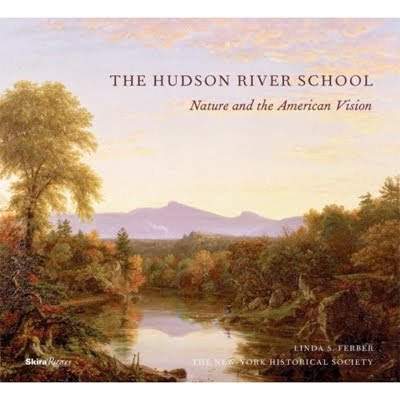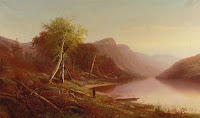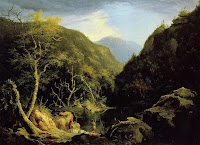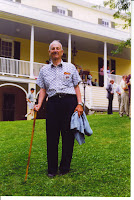 The Olana Partnership will celebrate the Hudson Valley’s extraordinary natural and designed landscapes in a symposium on Saturday, April 16, 2011. Framing the Viewshed: The Transformative Power of Art and Landscape in the Hudson Valley will take place at Columbia-Greene Community College, just outside of Hudson, New York. The panel discussion will feature three leading experts in the fields of art history, conservation, and landscape design who will discuss the Hudson Valley’s unparalleled viewsheds and their cultural context.
The Olana Partnership will celebrate the Hudson Valley’s extraordinary natural and designed landscapes in a symposium on Saturday, April 16, 2011. Framing the Viewshed: The Transformative Power of Art and Landscape in the Hudson Valley will take place at Columbia-Greene Community College, just outside of Hudson, New York. The panel discussion will feature three leading experts in the fields of art history, conservation, and landscape design who will discuss the Hudson Valley’s unparalleled viewsheds and their cultural context.
Olana, now the Olana State Historic Site, was the home and creation of Frederic Edwin Church (1826-1900), one of the most significant artists of his day, and a leader of the Hudson River School, America’s first native school of painting. As a young artist, Church studied under Thomas Cole who lived just across the Hudson River. Church fell in love with the area and, when he became successful he bought a farm, which eventually became one of America’s most important designed landscapes.
Frederic Church designed Olana, planting trees, building a lake, and orchestrating the paths and carriage drives that lead up to the iconic Persian-inspired castle at the top of the hill. From this vantage point, with Church’s 250-acre Picturesque style landscape in the foreground, and the larger, borrowed landscape stretching to the horizon, today’s visitor can enjoy a vista largely unchanged in the 110 years since Frederic Church died.
This vast area comprises the Olana viewshed. (Fittingly, Columbia-Greene College, site of the symposium, is itself part of this viewshed.) “Olana represents a rare American convergence of art, conservation and landscape themes,” said Mark Prezorski, trustee of The Olana Partnership. “It makes perfect sense for the Olana Viewshed to serve as a backdrop for a broader Hudson Valley discussion.”
The panel discussion will be moderated by David Schuyler, the biographer of Calvert Vaux, who assisted Church with the design of the house. Art historian Linda S Ferber will speak on the four Hudsons of Wallace Bruce, the author of a 1901 travel guide: the Hudsons of Beauty, History, Literature and Commerce. Vassar Professor Emeritus Harvey K. Flad will discuss the “Art of Protecting Scenic Views: Nineteenth-century Artists and the Preservation of Modern-day Landscapes.” Landscape architect Laurie Olin, whose designs for public and private landscapes have won him international acclaim, will speak on the use of contemporary design in historic settings.
The concept of viewsheds is one in which many organizations are involved, several of which are participating in this symposium by either helping sponsor the conference or having representatives on hand to talk about their work. Sara Griffen, President of The Olana Partnership, said, “Partnerships are key to understanding and preserving views. The Olana Partnership is pleased that the Hudson Valley Greenway and National Heritage Area are sponsors of the symposium, and that representatives of Scenic Hudson, the Open Space Institute, and the Columbia Land Conservancy will be available to describe their respective roles in the preservation of views. The Olana Partnership also acknowledges the critical work of the New York State Office of Parks, Recreation and Historic Preservation as well as the Estuary program of the NYS Department of Environmental Conservation and the Department of State, and the support of our partners at the American Society of Landscape Architects and the Cultural Landscape Foundation.” WDST is the media sponsor of the symposium.
Citing some reasons why his organization with its partners have preserved more than 2,000 acres in the Olana viewshed, Scenic Hudson President Ned Sullivan said, “These vistas are good for the soul and the economy. The land that inspired Frederic Church’s art today lifts the spirits of all who see it. Keeping this treasured landscape intact helps Olana bring $8 million to the local economy each year and contributes strongly to Columbia County’s tourism industry, which generates $105 million in spending annually and is responsible for 1,500 jobs. I applaud Olana for holding this symposium to have more people appreciate and support preserving the valley’s natural beauty.”
The symposium will be held from 1:00 to 5:00 p.m. on Saturday, April 16, at Columbia-Greene Community College, 4400 Route 23, Hudson, NY. Registration starts at 12:30 p.m. Tickets are $40 each for members of The Olana Partnership, $50 for non-members. Continuing Education Credits, LACES 3.5 Non-HSW (NYS) will be available for registered landscape architects. From 10:00 a.m. to 12 noon, Olana is offering tours of the Bell Tower (which is not usually open to the public) to symposium participants. The tour is free to members, $40 for non-members- space is limited so guests must pre-register. For additional information or to reserve tickets, go to the Olana website, www.olana.org or call (518) 828-1872, extension 103.
Another feature of this symposium is a collection of statements on the subject of viewsheds that will be provided to attendees. In addition, these statements are posted on Olana’s website, along with an opportunity for the public, through Facebook, to create their own statements about views.
Following the symposium, participants can enjoy the sunset by attending a Viewshed Benefit Party with wine and hors d’oeuvres, from 6:00-8:00 p.m. at Oak Hill in Hudson, NY (town of Livingston). Oak Hill was built around 1793 by John Livingston (1750-1822), son of Robert Livingston, the third Lord of Livingston Manor. Grandly sited on a Hudson River bluff, it commands intimate river and mountain views, as well as a singular view up toward Frederic Church’s house and painting studio. Oak Hill is one of more than a dozen family homes built along the Hudson River and has remained in the Livingston family since it was built. Sponsor tickets for the benefit are $250, members $90 and non-members $100 and are available by calling (518) 828-1872, extension 103 as well as via Brown Paper Tickets.
Photo: Peter Aaron/Esto.






